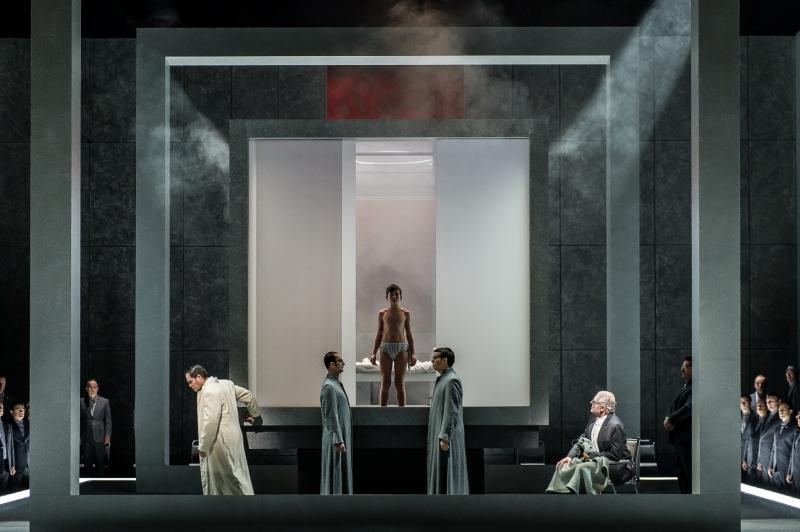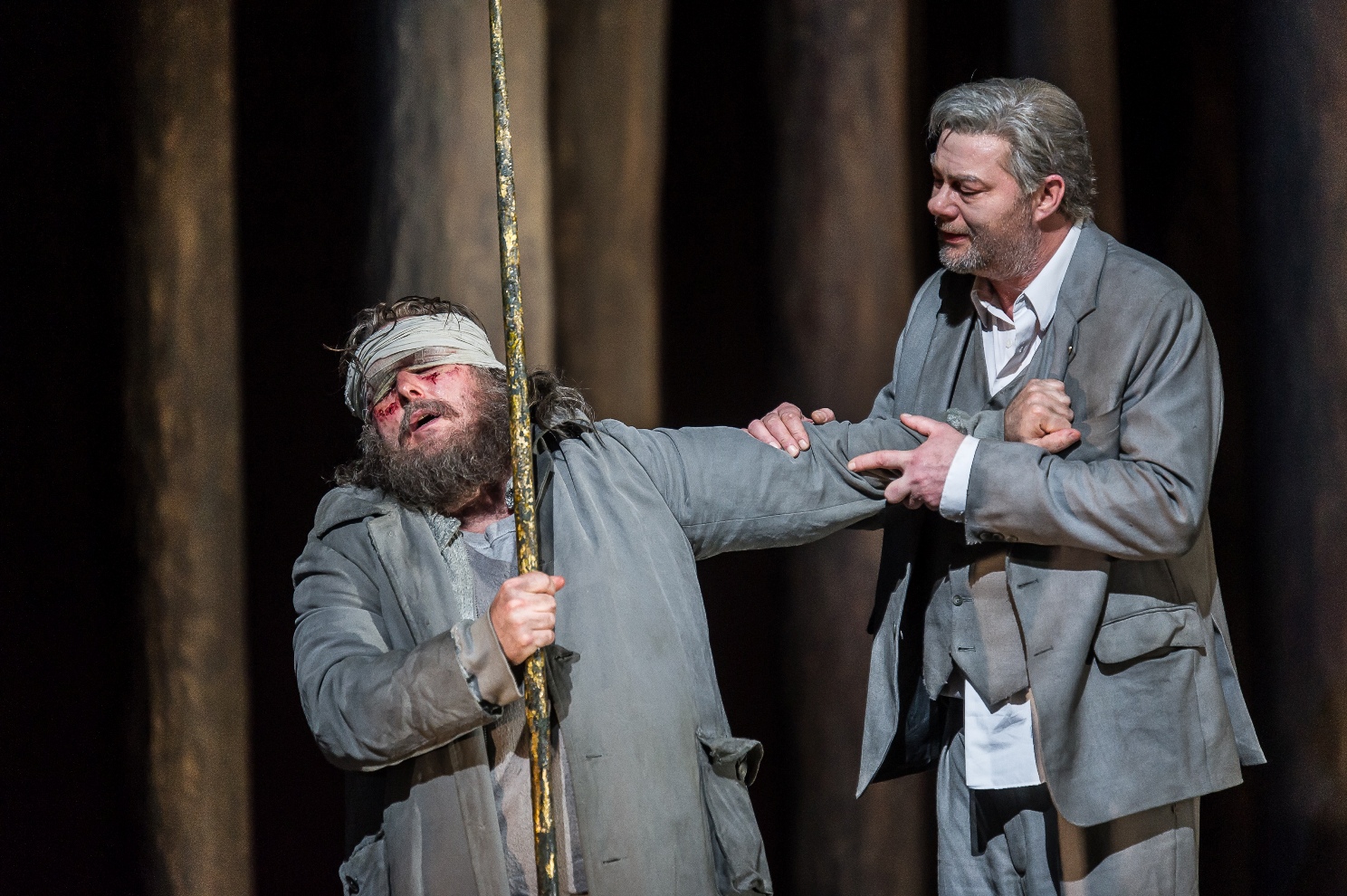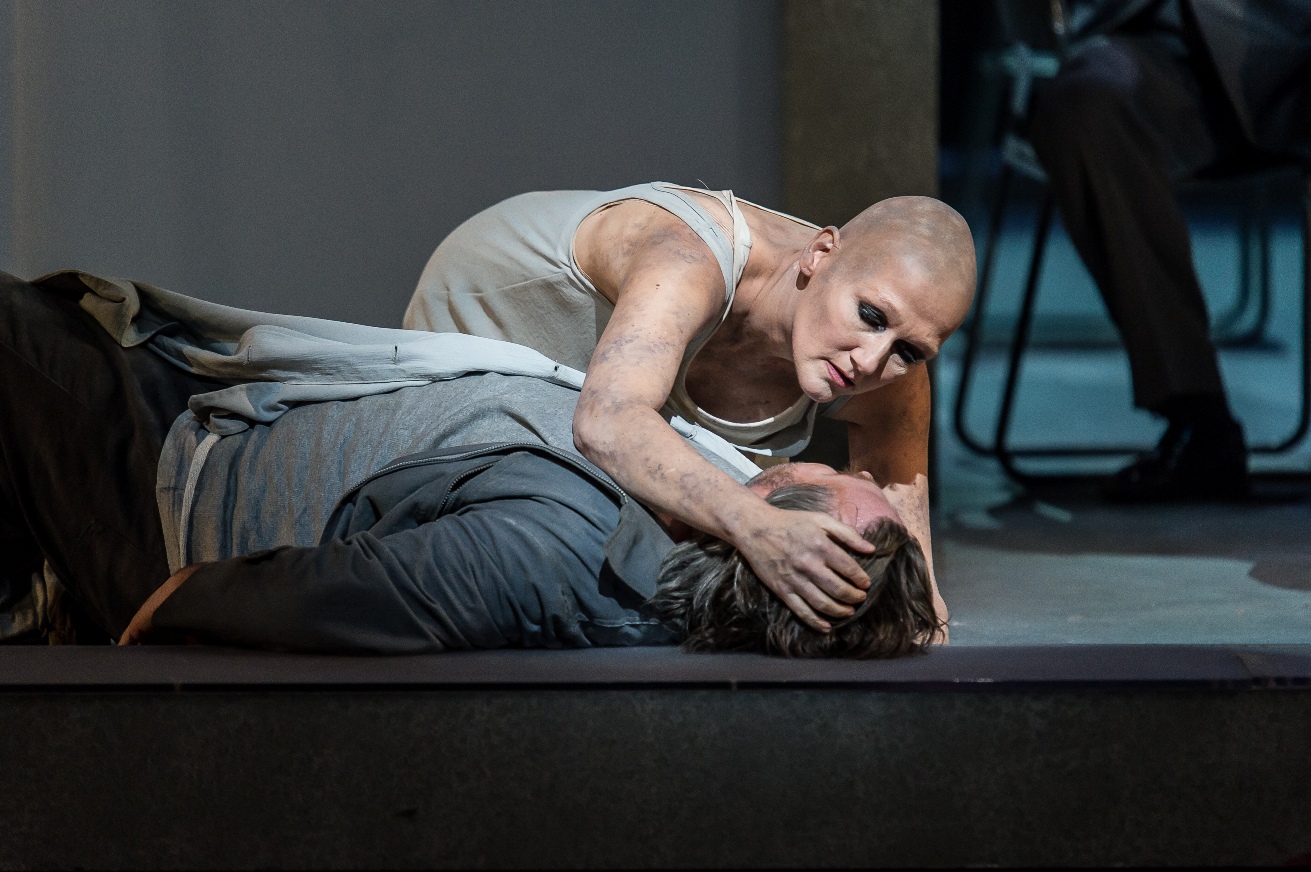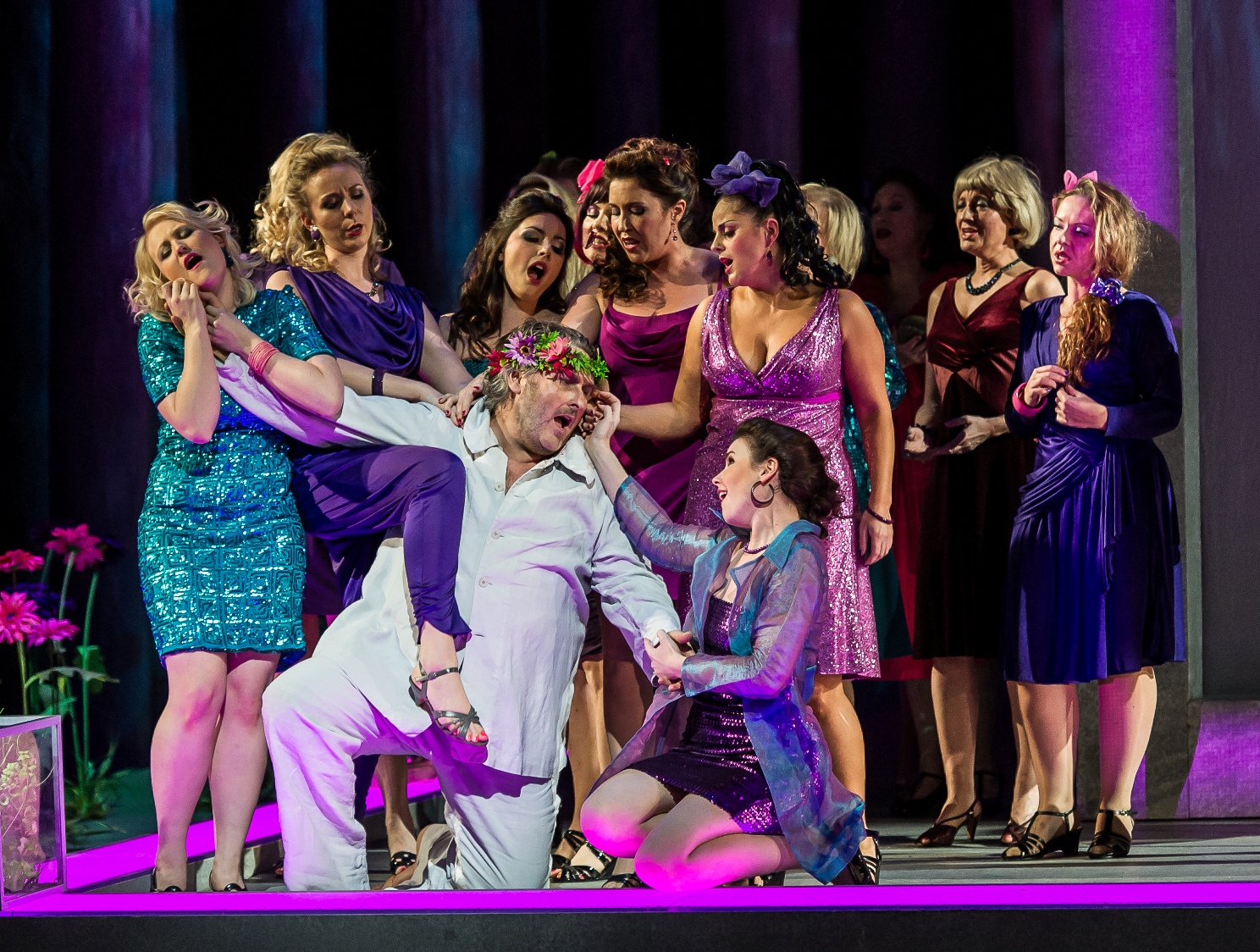


Is anyone else sick of creepy brotherhoods skewering the transcendent in Mozart’s and Wagner’s late operas? Both Sarastro’s cult and the company of the grail are in sore need of change - "fresh blood" would be an unfortunate term under the circumstances - when we first encounter them.
Langridge, who along with the present design team has done fine work on the powerful myth of Harrison Birtwistle's The Minotaur [3], is no doubt right to insist so much on grail celebrant Amfortas’s sickbed and drip. Central, certainly, is the horror of the undead ruler, pierced and wounded by a near-fatal dalliance with the most “dangerous” of the women who live on the margins of the secret society. So it's fair enough to present the hospital room, strip-lit in another cliché of alienation shared with the ENO Flute [4], as an ever-present centre-stage cube which “transforms” into the heart of the ceremony supposed to bring both daily relief and never-ending torment to the man who can’t die. Only here, in the first of many false steps, it’s the act itself – blood-letting of a pubescent boy (and to hell with the spoiler) – which disgusts both Gerald Finley’s tormented Amfortas, compelled to serve the needs of wheelchair-bound bloodsucker dad Titurel (Robert Lloyd), and Simon O’Neill’s appalled novice onlooker of a Parsifal. And us, too, if we’re human: this Parsifal wasn’t the only one who wanted to run away.
 Your attitude to all this will depend on whether or not you feel, as I do, that the director’s first duty is to honour the moments of grace amidst all the apocalyptic darkness – and it isn’t just a question of having a grail cup and a shining light. Langridge's repellent ritual cancels out all the good intentions in conductor Antonio Pappano’s finest half-hour-plus, his gentle pacing of Wagner’s transformation music and grail ceremony. With Pappano, though, if the sounds are always right and tell us how modern and pre-Debussyan the textures of this extraordinary endgame always are, the pacing isn’t.
Your attitude to all this will depend on whether or not you feel, as I do, that the director’s first duty is to honour the moments of grace amidst all the apocalyptic darkness – and it isn’t just a question of having a grail cup and a shining light. Langridge's repellent ritual cancels out all the good intentions in conductor Antonio Pappano’s finest half-hour-plus, his gentle pacing of Wagner’s transformation music and grail ceremony. With Pappano, though, if the sounds are always right and tell us how modern and pre-Debussyan the textures of this extraordinary endgame always are, the pacing isn’t.
It felt especially unhelpful to the long narrative of past history unfolded by René Pape [5]’s patient Gurnemanz after the Prelude. Pape (pictured above right with O'Neill's Parsifal in Act Three) has the most beautiful of bass timbres, he inflects the meaning well, but how – for the first time in my experience – all this essential information sagged perilously in the mouth of a narrator made by Langridge an unsympathetic cult-promoter. Pape is tested, too, by the generous outbursts of the last act, where Langridge comes closer to Wagner’s intended narrative with a Good Friday cleansing of the injured, newly experienced Parsifal by the “good father” and the now Magdalenesque Kundry.
Who remains, in Angela Denoke [6]’s dedicated interpretation, the most fascinating character in the opera: shaven-headed, dishevelled grail servant (pictured below with O'Neill in Act One), vamp under spell-bound compulsion and a woman finally restored to her noble wits. The voice isn’t exactly beautiful, there’s essentially only one colour, and it barely holds out for the final rants against a Parsifal newly aware of the weight of sin – but then the overtouted Waltraud Meier, for stage reasons alone the Kundry of choice over the past 30 years, couldn’t cut the mustard vocally there either.
 It doesn’t help that Pappano is again much too slow, however beautiful and sleepy the string sound, in Kundry’s weird incestuous seduction where she takes on the role of Parsifal’s mother. The red wig is the giveaway, along with the many tableaux of What Happened Earlier played out in the cube (in Act One, where they include acolyte-gone-bad Klingsor’s self-castration, they’re no substitute for the reactions of a Kundry who should be on stage all through Gurnemanz's narrative but for some reason isn’t here).
It doesn’t help that Pappano is again much too slow, however beautiful and sleepy the string sound, in Kundry’s weird incestuous seduction where she takes on the role of Parsifal’s mother. The red wig is the giveaway, along with the many tableaux of What Happened Earlier played out in the cube (in Act One, where they include acolyte-gone-bad Klingsor’s self-castration, they’re no substitute for the reactions of a Kundry who should be on stage all through Gurnemanz's narrative but for some reason isn’t here).
With Gerald Finley [7]’s Amfortas severely overparted and taxed to the extreme by Pappano letting his two narratives drag when at that point in each of the outer acts we want to get to the end, and Willard White’s Klingsor going through now familiar motions, it’s left to Simon O’Neill [8] to provide the best-connected singing of the evening. He’s no great shakes as an actor, at least under Langridge; here he stumbles and totters less convincingly than everyone else, and his get-up, especially the vest in which he slays the warriors of Klingsor’s castle, isn’t flattering. But how he can pull out the stops as he realizes the significance of Amfortas’s wound after Kundry’s kiss – the production has its moment here as a second cube is unveiled with the suffering grail king revealed behind the first – and how nobly he returns the stolen spear to the brotherhood at the end. It’s just a shame that the ultimate "redemption to the redeemer" is nothing more than a Wizard of Oz moment, a dissolution which should have happened much earlier.
 O'Neill also manages to be playful with the Flowermaidens of Klingsor’s enchanted garden (pictured right with O'Neill), who eventually shuck off their widows’ headscarves and do what we usually expect of them; there are some promising voices here in the mix, chiefly Anna Devin [9], Celine Byrne and Anna Patalong [10]. The female chorus, too, has a chance to make more of an impression than its male counterparts, marginalised by the ritual. Alison Chitty [11]’s designs and Paul Pyant’s lighting come into their own for the magic; either side of it, they're far too stuck with red, grey and black. So much for a forest which ought to be a sanctuary of green but consists only of leafless timber, much of it fallen in Act Three.
O'Neill also manages to be playful with the Flowermaidens of Klingsor’s enchanted garden (pictured right with O'Neill), who eventually shuck off their widows’ headscarves and do what we usually expect of them; there are some promising voices here in the mix, chiefly Anna Devin [9], Celine Byrne and Anna Patalong [10]. The female chorus, too, has a chance to make more of an impression than its male counterparts, marginalised by the ritual. Alison Chitty [11]’s designs and Paul Pyant’s lighting come into their own for the magic; either side of it, they're far too stuck with red, grey and black. So much for a forest which ought to be a sanctuary of green but consists only of leafless timber, much of it fallen in Act Three.
So Act Two, as usual with directors who don’t know what to make of the essential holiness, works best. Nor is its short Prelude scuppered like its counterparts in the outer acts - the first with a video image of Kundry's mouth - laughing at Christ, presumably - which has nothing to do with the music that's unfolding, the last with the deracination of the grail community when the strings speak of Parsifal's endless wanderings. The uncomfortable truth remains that with a grail gathering that’s the exact opposite of what Wagner intended – and it’s one of the few elements in the mystifying drama where we can be sure, however vaguely, that he intended celestial good - this evening, for all its fleeting musical pleasures, falls at the first hurdle.
Links
[1] https://theartsdesk.com/users/david-nice
[2] https://www.addtoany.com/share_save
[3] http://www.theartsdesk.com/opera/minotaur-royal-opera
[4] http://www.theartsdesk.com/opera/magic-flute-english-national-opera
[5] http://www.theartsdesk.com/opera/faust-royal-opera
[6] http://www.theartsdesk.com/opera/salome-royal-opera
[7] http://www.theartsdesk.com/opera/die-meistersinger-von-n%C3%BCrnberg-glyndebourne-festival-opera
[8] http://www.theartsdesk.com/classical-music/wagner-proms-remembered
[9] http://www.theartsdesk.com/opera/il-trittico-royal-opera-house
[10] http://www.theartsdesk.com/opera/dialogues-des-carm%C3%A9lites-guildhall-school-music-drama
[11] http://www.theartsdesk.com/opera/nabucco-royal-opera
[12] http://www.roh.org.uk/productions/parsifal-by-stephen-langridge
[13] http://www.davidnice.blogspot.co.uk/2013/11/parsifal-crystal-bells-magic-garden.html
[14] http://www.theartsdesk.com/opera/wagner-interviews
[15] http://www.amazon.co.uk/s/ref=nb_sb_noss_1/275-0108985-9146763
[16] https://theartsdesk.com/node/71484/view
[17] https://theartsdesk.com/node/72145/view
[18] https://theartsdesk.com/node/71999/view
[19] https://theartsdesk.com/node/3101/view
[20] https://theartsdesk.com/node/62713/view
[21] https://theartsdesk.com/opera
[22] https://theartsdesk.com/topics/roh
[23] https://theartsdesk.com/topics/wagner
[24] https://theartsdesk.com/topics/germany
[25] https://theartsdesk.com/topics/religion
[26] https://theartsdesk.com/topics/mythology
[27] https://theartsdesk.com/topics/19th-century
[28] https://theartsdesk.com/topics/reviews